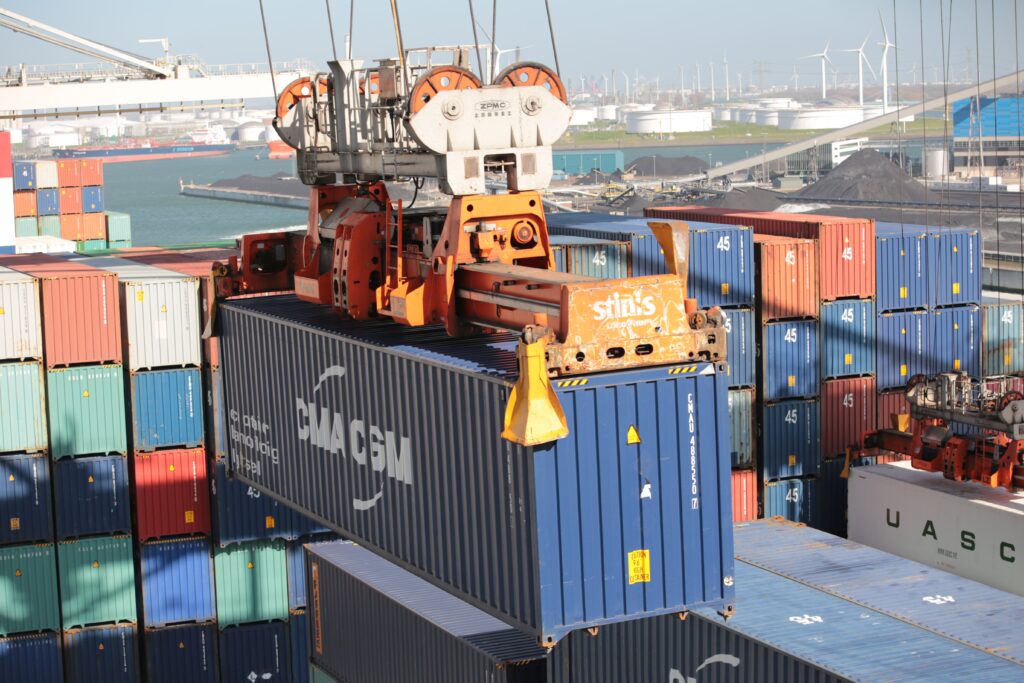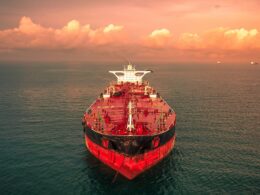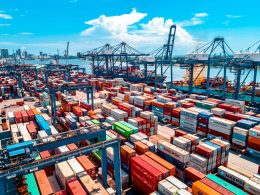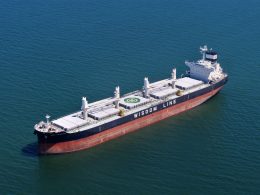The shipping container revolutionized the world of shipping logistics. Standardized shipping containers have led to lower costs, faster deliveries, and better services for traders, exporters, and importers.
Top Ten Largest Container Shipping Companies
- Maersk (Denmark)
- Mediterranean Shipping Company (MSC) (Switzerland/Italy)
- CMA GGM (France)
- COSCO (China)
- Hapag-Lloyd (Germany)
- Ocean Network Express (ONE) (JApan)
- Evergreen (Taiwan)
- HMM (South Korea)
- YangMing (Taiwan)
- ZIM (Israel)

The Most Common Shipping Costs
Terminal Handling Cost
Usually known as THC or Terminal Handling Costs, they refer to the expenses imposed by the port terminals. In particular, costs arising when the container/cargo is unloaded from an arriving vehicle at the port including costs such as labor, movement of cargo/container in the terminal through motorized trucks or special machinery.
Fuel Surcharge
Fuel surcharges refer to the extra expenses incurred due to the volatility of fuel prices. Shipping lines commonly charge its stakeholders a similar charge called fuel surcharge or known as BAF (Bunker Adjustment Factor). Shipping lines also generally include an extra additional charge when quoting cargo rates to cargo forwarders, which in turn directly translates to higher cargo rates.
Fuel surcharge for each shipment is assessed on the net freight charge in accordance with the fuel surcharge percentage.
For Example: Total Freight is $ 1000 & fuel percentage is 12 % for this month. It is calculated as below: $1000 x 12% = 12
Total freight paid by customer = $1000 + $120 = $1120
War Risk Surcharge
War risk surcharge is commonly forced by the shipping lines and varies significantly according to each route and port. This charge applies to shipments where there are potential risks of war due to the geographical area that it will transit.
The war risk surcharge is a compulsory extra charge forced via the cargo carriers and with the shared assent of the insurance agencies. It covers more than real conflicts (intrusion, uprising) including global emergencies where there is a concrete threat of war, and regions where considering (theft) is pervasive.
Examples of war risk areas include the Middle East Gulf Region (Oman, UAE, Qatar, Bahrain, Saudi Arabia, Kuwait, Iraq, Iran, etc.). War risk surcharge is pro-rated on Per TEU (Twenty Equivalent Unit) basis for customers.
Insurance
Insurance is considered as one of the most important risk-management elements in global trade, as it safeguards the customer from unpredictable events which may occur during the transit of the cargo during the shipment voyage. Some of the events covered under the most common shipping insurances are as follows:
- Collapse of onboarded containers
- Shipping Line Accident
- Cargo contamination with water.
- Cargo damaged due to infestation.
- Bad stowage of cargo
- Cargo gets wet in transit.
- Theft, Fire, Natural Calamity
- Packaging related issues: Poor quality packaging, Improper dunnage of cargo.
FCL vs LCL Shipments
FCL Shipment
FCL means Full Container Load.
FCL shipments contain generally just one commodity inside the shipping container shipped by one single exporter or shipper.
FCL offers more flexibility, as there is no need to consolidate the cargo in the container with other shippers, and thus the shipper may fill and ship the container as without the need to consolidate with other shippers.
LCL Shipment
LCL shipments feature multiple shippers and/or exporters, thus requiring consolidation.
LCL shipments offer less flexibility, as the shipper will need to consolidate with a number of other parties and thus more time and documentation will be required.
In many cases, shipping FCL may be more economical than trying to ship LCL, even if the cargo does not reach the technical max capacity.
Most Common Shipping Documents
B/L
The Bill of Lading, also known as BL or BoL, is the main shipping documents in ocean freight shipments.
The BL is a document issued by a carrier, or its agent, to the shipper as a contract of carriage of goods. It is also a receipt for cargo accepted for transportation and must be presented to the shipping line in order to take delivery at the destination.
A Bill of Lading has three primary functions:
- It is a contract of carriage between the carrier and the shipper.
- It is a receipt for shipped goods.
- It serves as a document of the title of the goods.
The Original Bill of Lading (aka OBL) is issued in a set of 3/3 Copy where 3 Copies are Original BL copies, and 3 Copy are Non-Negotiable.
The BL is a key shipping document that allows for efficient transfer of ownership while maintaining firm risk management practices against counterparty risk.
SWB
The Express SWB (Sea Way Bill of Lading) is similar to the BL, however much more efficient and preferred by long-time trading partners that trust each other.
When traders or operators use SWB, the cargo can be released upon presenting the digital copy of the SWB. This means that delivery is much easier compared to using Original BLs, whereby hard copies will need to be submitted by the consignee to the shipping line for the release of cargo at destination.
ICO
The International Certificate of Origin, also known as the COC (Chamber of Commerce)/ COO (Certificate of Origin), is a document/certificate issued by the International Chamber of Commerce to the exporter or its agent.
This certificate certifies the geographical origin of the traded commodity and also contains information regarding the product, its destination, and the country of export.
Phytosanitary Certificate
The Phytosanitary Certificate (PSC) is an official report required for trading/re-shipping agricultural, animal, and some other controlled products or commodities. The main purpose of the PSC is to demonstrate that the commodities or products meet certain Phytosanitary import rules and regulations. They may likewise frequently be expected to cover contaminated articles, for example, void steel trailers, vehicles, or different organic entities. In the event that the transporter wasn’t able to provide the merchant a phytosanitary testament, the items would almost certainly not be endorsed by customs.
Sales Invoice
The sales invoice, or commercial invoice, is the main commercial document issued by the seller to the buyer, which often is the consignee. It includes the following information:
- Incoterms delivery terms
- Quantity
- Price
- Value of the shipment
- Seller details
- Buyer details
In some cases, the commercial documents may have included a proforma invoice, which is basically a provisional sales invoice and will be used by the buyer to clear customs and in some cases arrange for financing and storage.
Packing List
The packing list accompanies the rest of the commercial and shipping documents with the purpose of logging the content of the goods shipped. The packing list usually includes:
- Container Number
- Container Seal Number
- Ship’s Name
- Shipping Line
- Port of Loading
- Port of Discharge
- Port or Ports of Transshipment
- Gross Weight (Shipped Weight)
- Net Weight
Shipping Bill
Shipping bill is one of the most important documents required by the Customs Authorities. The shipping bill is filed on the basis of commercial documents which are provided by the supplier to the agent.
It contains all the important details of the shipment i.e, supplier & buyer details, commodity name item-wise, classification of commodity, tariff codes, Port of loading & destination, Net weight, Gross Weight, Value of shipment, any benefit that exporter needs to take, etc.
There are two types of shipping bills: Dutiable Shipping Bill and Duty Drawback Shipping bill

Who’s Who In Shipping?
Shipper
A shipper is a person or company responsible for shipping and exporting a particular commodity from the point of origin to the point of destination. Alternative names for shipper are: Seller / Supplier / Consignor / Exporter, although in some cases there are not the same.
Consignee
The Consignee is defined as a party who intends to receive the shipment from the Exporter at the point of destination. Alternative used terms for consignee are: Buyer / Importer, although in some cases the BL will be consigned “to order”, which then makes it much easier and confidential to trade afloat after issuing the documentation.
Shipping Line
Shipping Lines are referred to as the carriers of the VOCC (Vessel operating common carriers), and own or operate the container ships. They act as transportation agents for the Shipper & Consignee, transporting the cargo from one point of origin to the other parts of the world.
A Shipping Line is a company that operates the ships that actually carry the containers (owned or leased) and cargo from load port to discharge port.
Surveyors:
A surveyor is a person or company that examines the condition of the goods and container before allotting them to any exporter.
Often overlooked, they play a very important role in commodity trading, as they certify and monitor shipments as neutral 3rd parties appointed by the seller, buyer, or shipping lines. Some of the famous 3rd party surveyors include SGS, Saybolt, Intertek, or Bureau Veritas.
Surveyors play an important role in containerized shipping, although admitedly a lesser role than in bulk commodities where they are absolutely essential.
Shipping Agents
A shipping agent is a person or company who deals with the transactions of a ship in every port that the ship visits or docks. In simple terms, it is a shipping agent who with a local expert acts as a representative of the owner of the ship and carries out all essential duties and obligations required by the crew of the ship.
It is the ship agent who is entrusted with taking care of every need and requirement of the crew like getting local currency, getting the mail, seeking a repairmen in case the ship requires major repairing, refilling the food and water containers, and many other such duties. They can act as NVOCC as well who used to deal with shipping lines for shipping the cargo.
Main Problems In Container Shipping
Delays
Delays are the most basic and common problems associated with container shipments. Shipping delays arise to problems in the shipping schedules, weather conditions, mechanical failures, transit times, on crew problems.
Additional reasons for shipping delays include port blockages, vessels skipping calls at the port, longer transit times due to vessel breakdown, port congestion, and others.
Lost Containers
Although still very uncommon, occasionally extreme weather at sea or an accident may lead to container ships losing cargo. In any case, it seems that the trend is accelerating.
Damages
Damages during shipping are a lot more common than losing the container altogether. The most common dagamages include:
- Physical Damage – Physical damage is where cargo is damaged due to dropping, breakages, being knocked during transit, etc.
- Wet Damage – Wet damage occurs when the cargo is damaged by water.
- Contamination Damage – It occurs when cargo is damaged due to contamination.
- Infestation Damage – In some cases, the cargo may suffer from infestation while afloat.








